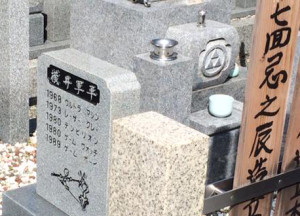Why is the Triforce on Game Boy Creator Gunpei Yokoi’s Grave?
Posted on May 15 2015 by Alexis S. Anderson
 The Japanese are often buried on family plots, and the central stone in these plots will bare the family’s crest or “kamon.” In the case of Gunpei Yokoi, his family’s kamon bears a striking resemblance to the Triforce from our very own Legend of Zelda. Its appearance on the Yokoi plot peaked gamers’ interests considering who Gunpei Yokoi was. Yokoi was the creator of the Game Boy and an early game developer for Nintendo; he formulated the Game & Watch system and games, and is even referred to as Shigeru Miyamoto’s mentor. For these reasons, fans speculate that the Triforce in the Legend of Zelda was a nod to Yokoi, but this hasn’t proved to be entirely accurate. To read more about the theory and the Triforce’s Japanese origins, hit the jump!
The Japanese are often buried on family plots, and the central stone in these plots will bare the family’s crest or “kamon.” In the case of Gunpei Yokoi, his family’s kamon bears a striking resemblance to the Triforce from our very own Legend of Zelda. Its appearance on the Yokoi plot peaked gamers’ interests considering who Gunpei Yokoi was. Yokoi was the creator of the Game Boy and an early game developer for Nintendo; he formulated the Game & Watch system and games, and is even referred to as Shigeru Miyamoto’s mentor. For these reasons, fans speculate that the Triforce in the Legend of Zelda was a nod to Yokoi, but this hasn’t proved to be entirely accurate. To read more about the theory and the Triforce’s Japanese origins, hit the jump!
Fans who’ve traced the Triforce’s history in Japan have found that it was normally the crest of the powerful Hojo clan, so for it to appear on Yokoi’s plot seemed a strange surprise. However, many kamon have come to be used by multiple families throughout Japan’s history– whether they were bought out or just plain adopted by new families. At first kamon were like coats of arms reserved for wealthy families or samurai, but the merchant classes began to use them by the 17th century, and families were creating their own by the 19th.
Despite the Triforce being a “mitsuuroko,” meaning “three scales,” and belonging to the Hojo clan, the rather simple symbol saw wider use from the 19th century into the present. In fact it’s one of the most popular and common symbols in Japanese culture, one that Miyamoto would have been aware of even without having known Yokoi. It’s likely the symbol was chosen because of its public recognition and easy-to-program design, and not likely as a reference to Gunpei Yokoi. Yokoi would have had chances to show off his kamon at work before, so there is a good chance Miyamoto knew he was tied to the mitsuuroko. Of course, Miyamoto has not commented on the subject, so while there is a chance that the Triforce was chosen in part to recognize Yokoi, all we can do is hypothesize.
The mitsuuroko is now most globally known as a Triforce, and youths in Japan would identify it as such more often than not as well. So we can thank the Legend of Zelda for erasing years of cultural significance from a family’s kamon. I jest, the series has only made the symbol more powerful! What’s your take on Yokoi’s contribution to the use of the Triforce in The Legend of Zelda? Was it just a coincidence, or a direct allusion to the inventor of the Game Boy? And do you find the history of the Triforce interesting? Share your opinions in the comments!
Source: Kotaku

Alexis S. Anderson is a Senior Editor at Zelda Dungeon who joined the writing team in November, 2014. She has a JD from the UCLA School of Law and is pursuing a career in Entertainment and Intellectual Property Law. She grew up in the New Jersey suburbs with her parents, twin brother, and family shih-tzu.




